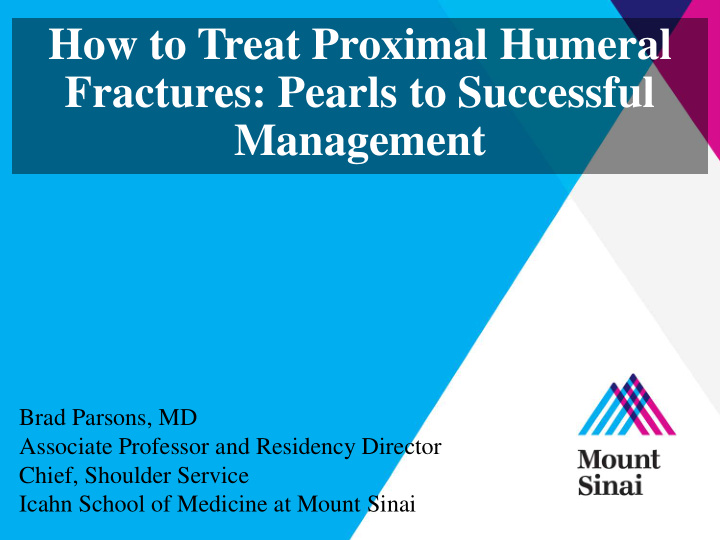



How to Treat Proximal Humeral Fractures: Pearls to Successful Management Brad Parsons, MD Associate Professor and Residency Director Chief, Shoulder Service Icahn School of Medicine at Mount Sinai
Conflict of Interest • Consultant: – Arthrex, Inc
Spectrum of Challenges • Historically many managed nonoperatively – “Acceptable outcomes”
Patient Selection
Patient Factors • Majority of patients older – Osteoporotic fracture • Comminution • Challenging ORIF • Historically nonop or Hemi • Weightbearing arms – Not always “low demand” • Preserve independence?
Case 1: 77 y/o female, LHD
X-Rays Provide the Bulk of Information APER Outlet Axillary
CT Can Be Helpful Too
Beware the Varus Fx • Varus is a problem – Calcar Comminution – Unstable – Often progresses – Highest rate of hardware failure and cutout
Valgus Impacted Fracture • Doesn’t fit well into a classification system – Lower AVN rate – Special consideration for treatment – Jakob et al. JBJS. 73B. 1991
Understanding the Deforming Forces
Don’t Forget About Version
Which Fx’s Do I Non-op? • Preserved relationships: – Preserved head-tuberosity relationship – Minimal varus (tuberosity) – Valgus tolerated better – No block to rotation (version) • Nondominant > dominant • Pt education of outcome
Surgical Indications/Options • Displaced Fx ’ s in Active Patients – Distorted Anatomy • Tub-Head • Head Inclination • Version • Options: – Fixation • Percutaneous Tx • ORIF with locked plate – Arthroplasty • Hemi vs. Reverse
Indications for ORIF • Most Fractures – 2, 3 and 4-parts – Varus Fx ’ s – Valgus Impacted • Too late for pinning • Osteoporotic Fxs • Comminution
Classic Arthroplasty Fx Indications • 4 Part Fx-Dislocation • Head Split • Elderly 4-Part/ Some 3- Part • Some Chronic Situations – Nonunion – Malunion
When Do I Do a Hemi? • Younger, unreconstructable (e.g. head split) • Older but good tuberosities (not comminuted) • Good protoplasm • Physiologic demands
Indications for Reverse • Elderly patient (> 75) • Poor tuberosity bone – Comminuted – Osteopenic • Preexisting cuff tear? • Preexisting OA/DJD • Poor protoplasm for tuberosity healing
Goal of Surgery: Restore Relationships • Anatomic is Best – Not always possible – Elderly comminuted fxs • Restore Calcar Integrity – Bone Contact Key • Tuberosity Relationships – Restore Inclination – Restore Version
Conclusions • Most Fx’s can be non-op • Close monitoring: – Especially varus fx’s • Tuberosity malposition poorly tolerated • Most surgical indications is ORIF • Reverse >> Hemi
Thank You The Mount Sinai Medical Center, New York, NY
Recommend
More recommend